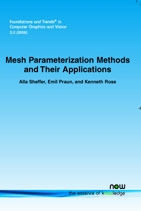Mesh Parameterization Methods and Their Applications
By Alla Sheffer, University of British Columbia, Canada, sheffa@cs.ubc.ca | Emil Praun, Google, USA | Kenneth Rose, University of British Columbia, Canada, kenrose@cs.ubc.ca
Abstract
We present a survey of recent methods for creating piecewise linear mappings between triangulations in 3D and simpler domains such as planar regions, simplicial complexes, and spheres. We also discuss emerging tools such as global parameterization, inter-surface mapping, and parameterization with constraints. We start by describing the wide range of applications where parameterization tools have been used in recent years. We then briefly review the pertinent mathematical background and terminology, before proceeding to survey the existing parameterization techniques. Our survey summarizes the main ideas of each technique and discusses its main properties, comparing it to other methods available. Thus it aims to provide guidance to researchers and developers when assessing the suitability of different methods for various applications. This survey focuses on the practical aspects of the methods available, such as time complexity and robustness and shows multiple examples of parameterizations generated using different methods, allowing the reader to visually evaluate and compare the results.
Mesh Parameterization Methods and Their Applications
Parameterizations between surface meshes and a variety of domains have numerous applications in computer graphics and geometry processing. In recent years numerous methods for parameterizing meshes have been developed, targeting diverse parameter domains and focusing on different parameterization properties.
Mesh Parameterization Methods and their Applications reviews the various parameterization methods, summarizing the main ideas of each technique and focusing on the practical aspects of the methods. It also provides examples of the results generated by many of the more popular methods. When several methods address the same parameterization problem, the survey strives to provide an objective comparison between them based on criteria such as parameterization quality, efficiency and robustness.
Mesh Parameterization Methods and their Applications provides guidance to researchers and developers when assessing the suitability of different methods for various applications. The authors focus on the practical aspects of the methods available, such as time complexity and robustness. They also provide multiple examples of parameterizations generated using different methods, allowing the reader to visually evaluate and compare the results.
